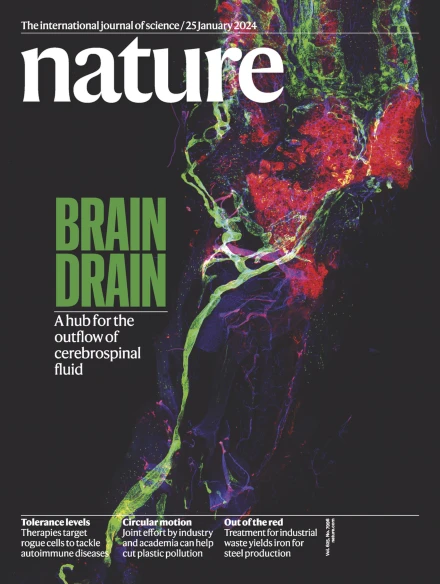Superconductivity in an infinite-layer nickelate
IF 50.5
1区 综合性期刊
Q1 MULTIDISCIPLINARY SCIENCES
引用次数: 593
Abstract
The discovery of unconventional superconductivity in (La,Ba)2CuO4 (ref. 1) has motivated the study of compounds with similar crystal and electronic structure, with the aim of finding additional superconductors and understanding the origins of copper oxide superconductivity. Isostructural examples include bulk superconducting Sr2RuO4 (ref. 2) and surface-electron-doped Sr2IrO4, which exhibits spectroscopic signatures consistent with a superconducting gap3,4, although a zero-resistance state has not yet been observed. This approach has also led to the theoretical investigation of nickelates5,6, as well as thin-film heterostructures designed to host superconductivity. One such structure is the LaAlO3/LaNiO3 superlattice7–9, which has been recently proposed for the creation of an artificially layered nickelate heterostructure with a singly occupied $${d}_{{x}^{2}-{y}^{2}}$$ band. The absence of superconductivity observed in previous related experiments has been attributed, at least in part, to incomplete polarization of the eg orbitals10. Here we report the observation of superconductivity in an infinite-layer nickelate that is isostructural to infinite-layer copper oxides11–13. Using soft-chemistry topotactic reduction14–20, NdNiO2 and Nd0.8Sr0.2NiO2 single-crystal thin films are synthesized by reducing the perovskite precursor phase. Whereas NdNiO2 exhibits a resistive upturn at low temperature, measurements of the resistivity, critical current density and magnetic-field response of Nd0.8Sr0.2NiO2 indicate a superconducting transition temperature of about 9 to 15 kelvin. Because this compound is a member of a series of reduced layered nickelate crystal structures21–23, these results suggest the possibility of a family of nickelate superconductors analogous to copper oxides24 and pnictides25. Superconductivity is demonstrated in an infinite-layer nickelate similar to infinite-layer copper oxides, which is synthesized using soft- chemistry topotactic reduction of the perovskite precursor phase.

无限层镍酸盐的超导性
在 (La,Ba)2CuO4(参考文献 1)中发现的非常规超导电性激发了人们对具有类似晶体和电子结构的化合物的研究,目的是找到更多的超导体并了解氧化铜超导电性的起源。同种结构的例子包括块体超导 Sr2RuO4(参考文献 2)和表面电子掺杂的 Sr2IrO4,后者显示出与超导间隙一致的光谱特征3,4,尽管尚未观测到零电阻状态。这种方法还引发了对镍酸盐5,6 以及旨在承载超导的薄膜异质结构的理论研究。其中一种结构是 LaAlO3/LaNiO3 超晶格7-9,最近有人提出用这种结构来创建具有单占据$${d}_{x}^{2}-{y}^{2}$带的人工分层镍酸盐异质结构。在以前的相关实验中没有观察到超导现象,这至少部分归因于 eg 轨道的不完全极化10。 在这里,我们报告了在无限层镍酸盐中观察到的超导现象,这种镍酸盐与无限层铜氧化物11-13 是同结构的。利用软化学拓扑还原法14-20,通过还原过氧化物前驱相合成了 NdNiO2 和 Nd0.8Sr0.2NiO2 单晶薄膜。NdNiO2 在低温下会出现电阻上升,而 Nd0.8Sr0.2NiO2 的电阻率、临界电流密度和磁场响应测量结果表明其超导转变温度约为 9 至 15 开尔文。由于该化合物是一系列还原层状镍酸盐晶体结构的成员21-23,这些结果表明有可能出现类似于铜氧化物24 和 pnictides25 的镍酸盐超导体系列。与无限层铜氧化物相似的无限层镍酸盐也具有超导性,它是利用软化学拓扑定向还原过氧化物前驱相合成的。
本文章由计算机程序翻译,如有差异,请以英文原文为准。
求助全文
约1分钟内获得全文
求助全文
来源期刊

Nature
综合性期刊-综合性期刊
CiteScore
90.00
自引率
1.20%
发文量
3652
审稿时长
3 months
期刊介绍:
Nature is a prestigious international journal that publishes peer-reviewed research in various scientific and technological fields. The selection of articles is based on criteria such as originality, importance, interdisciplinary relevance, timeliness, accessibility, elegance, and surprising conclusions. In addition to showcasing significant scientific advances, Nature delivers rapid, authoritative, insightful news, and interpretation of current and upcoming trends impacting science, scientists, and the broader public. The journal serves a dual purpose: firstly, to promptly share noteworthy scientific advances and foster discussions among scientists, and secondly, to ensure the swift dissemination of scientific results globally, emphasizing their significance for knowledge, culture, and daily life.
 求助内容:
求助内容: 应助结果提醒方式:
应助结果提醒方式:


